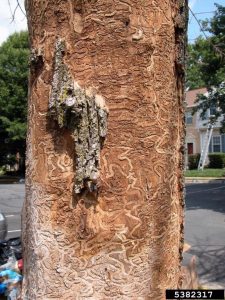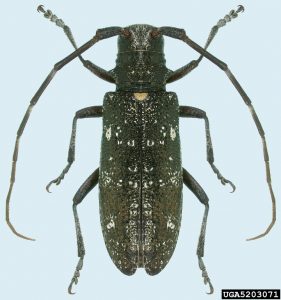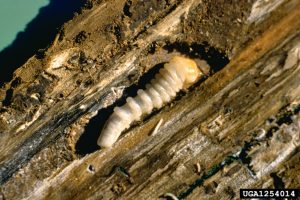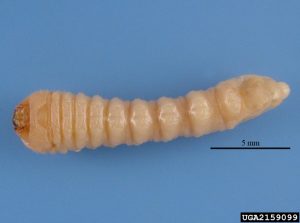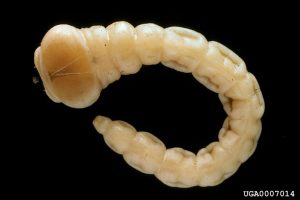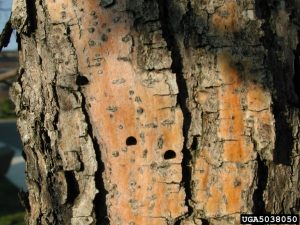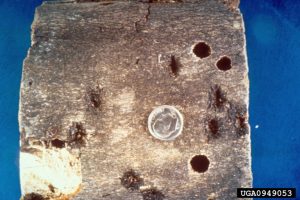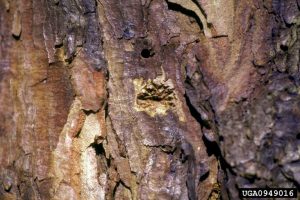Learning Objectives
- To learn what wood boring insects are and how they damage trees
- To learn common types of wood boring insects in Alaska
- To learn how to identify signs and symptoms of wood borer activity
- To learn potential wood boring insect threats to Alaska
- To become familiar with the vocabulary associated with wood boring insects
What are wood borers and how do they damage trees?
Wood boring insects are insects that bore into the sapwood and sometimes the heartwood of trees and shrubs. Typically, wood boring insects, referred to from here on as wood borers, infest weakened, dead, or dying trees and play an important ecological role in the decomposition process in forests. However, some wood borers can be damaging pests such as those that infest otherwise healthy living trees or those that infest recently harvested logs and bore into the heartwood, damaging wood for lumber or wood products.
Damage from wood borers is primarily done by the larvae (the immature stage of the insect). Wood borers tunnel and feed under the bark in the living wood of the tree, called the cambium. A diagram of the components of a tree can be found here. When wood borers infest living trees, this destroys the water and sap conducting tissues and results in girdling. Other issues related to wood borer damage can include structural weakness, branch dieback, general decline, disease transmission, and death. When wood borers tunnel into the heartwood it can cause degradation of wood or wood products and can impact the timber value.
Several different types of insects are categorized as wood borers, the most common being beetles, moths, and wood wasps. In the beetle order (Coleoptera), the families Cerambycidae and Buprestidae are the primary wood borers. Bark beetles (discussed in Module 3) are generally not considered wood borers because while they feed under the bark, they do not bore into the sapwood or heartwood of the trees. For the moth and wasp orders, it is the families Sesiidae and Siricidae, respectively, that are most commonly wood borers. The scope of this module is specifically focused on potential invasive wood borers in the beetle family Cerambycidae.
Cerambycidae – Longhorn beetles/roundheaded wood borers
As adults, Cerambycidae are commonly referred to as the longhorn beetles, longhorned beetles, or longicorn beetles and are named because of their long antennae. Larvae of Cerambycidae are called roundheaded wood borers and are the culprits of most of the damage done by this group.
Roundheaded wood borers can
- Girdle trees
- Weaken branches and stems
- Degrade logs for lumber or pulp
- Introduce stain fungi that degrades lumber and may contribute to tree death
- Vector pathogens
Monochamus adult
Adults are elongate and cylindrical and can be very brightly colored. The antennae are typically as long as or longer than the body.
Monochamus larvae:
Larvae are white legless grubs with soft cylindrical bodies. The head area is less distinct and primarily consists of the mouthparts.
Bycid and buprestid larvae:
Roundheaded wood borers are found in weakened, dead, or dying trees; though some are known to attack otherwise healthy trees. Adults chew round to oval-shaped exit holes. The size and shape of an exit hole can help determine what kind of wood borer may be present.
Exit holes:
Life history
Wood borers have diverse and varied life cycles depending on the group and species of insect. The main commonality between them is that they all spend a portion of their life beneath the bark of trees.
Females lay eggs in notches in the bark or in bark crevices or other protected areas. When the eggs hatch, the larvae bore galleries beneath the bark and into the heartwood of the tree.
Some species of wood boring insects are host specific, only attacking one species of tree, but many are polyphagous, feeding on more than one species. Both conifer and hardwood trees are attacked by wood borers.
Signs and symptoms of wood borers
When we talk about signs and symptoms in forest health, we are referring to the clues used to help diagnose a tree health problem.
Signs are physical evidence of the pest itself. Examples of signs include:
- Insect or animal evidence
o Holes in bark or leaves
o Frass
o Actual insects present causing damage
- Fruiting bodies of fungi
o Conks
o Mushrooms
- Bacterial ooze
Signs of wood borer activity include:
- Exit holes in bark
- Feeding galleries beneath bark
- Actual insects (any life stage)
- Boring dust accumulating at the base of tree or on bark (Longhorn beetle boring dust can look like wood shavings)
- Egg niches chewed in bark
>>Image(s) of wood borer signs
Bugwood1393006 – ALB galleries and exit holes
Bugwood0949016 – Monochamus sp egg notch and exit hole
Bugwood5378299 – Monochamus boring dust<<
Symptoms are the plant’s response to a pest. Examples of symptoms include:
- Leaf discoloration, spots, or distortion
- Branch dieback
- Stem lesions
- Galls
Symptoms of wood borer activity include:
- Branch dieback
- Leaf discoloration
- Premature leaf drop
- Excessive sap or resin flow
- Epicormic branching
>>Image(s) of wood borer symptoms
Bugwood5038047 – EAB crown dieback
Bugwood5331008 – Tetropium fuscum resinosis<<
Symptoms for multiple pests/disorders can be similar. Symptoms should be used to initiate a closer inspection of a tree and should be used in conjunction with signs of a pest to make a diagnosis. Never confirm a diagnosis on symptoms alone!
Invasive wood borers
Wood borers can be easily and unintentionally moved from place to place since they spend a good portion of their life hidden beneath the bark or within the wood of a tree. Common pathways for invasive wood borers include
- In wood packaging material such as pallets or crates
- In living plants
- In firewood
Some wood borers are attracted to lights and can also be transported as general hitch-hikers on goods stored outside at shipping facilities.
Several invasive wood borers threaten Alaskan forests. While none have been detected or currently exist in Alaska, they all pose a threat and could be introduced through travel or trade. A few longhorn beetles top the list as potential threats to Alaska’s trees, the Asian longhorned beetle (Anoplophora glabripennis), the brown spruce longhorn beetle (Tetropium fuscum), and the black spruce beetle (Tetropium castaneum).
>Images of adult<< ALB, BSLB, and BSB
Bugwood5449525 ALB adult, Bugwood5455679 T. fuscum adult, Bugwood5455678 T. castaneum adult<<
The Asian longhorned beetle is a pest that is currently found in several locations in the eastern United States. Aggressive detection and eradication programs are in place in these areas, as well as quarantines for movement of infested or potentially infested items.
Asian longhorned beetle attacks a wide range of host material, but primarily hardwoods. In Alaska, hosts include native species such as willow, poplar, and birch and ornamental species such as maple.
>>Image of adult
Bugwood1262002 – ALB adult female
Bugwood1262001 – ALB adult male<< (include size references)
Adult Asian longhorned beetles are shiny black with white spots. They have distinctive white and black striped antenna and blueish gray legs.
>>Image of larva
Bugwood1262005 – ALB larvae<<
Asian longhorned beetle larvae are creamy white and legless.
Asian longhorned beetles may be confused with one of our native longhorn beetles, the white-spotted sawyer.
>>Image of monochamus vs. anoplophora
Bugwood5203071 – Monochamus adult
Bugwood5449525 – ALB adult<<
Asian longhorned beetle adults differ from the native white-spotted sawyer in several ways:
Asian longhorned beetle
- Distinctly striped antenna
- Shiny black body
- Distinctly spotted elytra with bright white spots
- No white spot at base of elytra
White-spotted sawyers
- Antennae not as distinctly striped
- Dull black body
- Spots are less distinct to absent and never bright white
- White spot at base of elytra
[JM1]
>>ALB signs and symptoms video https://www.youtube.com/watch?v=yh6hyMNN0W0<<
The brown spruce longhorn beetle, Tetropium fuscum, (BSLB) is not currently known to exist in the United States; however, it is present in Nova Scotia, Canada and has been detected and eradicated in New Brunswick, Canada.
>>Map of BSLB http://www.inspection.gc.ca/DAM/DAM-plants-vegetaux/STAGING/images-images/protect_riskmgmt_13-02_image1_1410463526786_eng.jpg
The black spruce beetle, Tetropium castaneum, is also not currently known to occur in the United States; however, it has been detected in traps in Oregon and British Columbia, Canada.
Both of these species are pests of conifers, mainly spruce and pine but larch and fir trees are also potential hosts. BSLB is a pest of weakened, dying, or recently felled trees, though it has been found infesting and killing healthy red spruce in Nova Scotia.
>>Adult Tetropium spp
Bugwood5455679 – Adult T. fuscum<<
Adults are brown to reddish-brown with a dark brown or black head and can range between 1/3 to ¾ inches long. The elytra may have 2-3 longitudinal stripes. The antennae are about ½ the length of the body.
>>Larvae of Tetropium spp
Bugwood5331018 – Tetropium larvae<<
Larvae are yellow-white, legless, and ½ to 1 inch long. The head is reddish-brown.
These two species are very difficult to tell apart and distinguish from our native Tetropium. Positive identification will require examination of adults by a trained taxonomist.
Signs and Symptoms of Tetropium spp. include:
- Excessive resin flow down the trunk
- Larval entrance holes (~1/8 inch in diameter)
- Galleries under bark
- Browning of foliage
- Presence of adult beetles (likely active in late spring and summer)
>>Image(s) of Tetropium signs/symptoms
Bugwood1121049 – T. castaneum galleries
Bugwood5331008 – Tetropium resinosis<<
Scouting for invasive wood borers
When assessing tree health, there are some things to keep in mind that could help to find or identify invasive wood boring insects early. For wood borers, look for signs and symptoms from late spring through summer.
Eggs/Egg notches: Eggs may not be visible without very close inspection; however the egg notches chewed by Asian longhorned beetles will be easily visible, especially when fresh. Females will begin laying eggs soon after they emerge in mid-summer in notches on branches, the trunk, or exposed roots of trees.
Adults: Adults are likely to be present from late spring through summer. Look for adults on potential host trees feeding on foliage or searching for mates or egg laying sites. Adults may also be seen scurrying up and down the base of the tree or large limbs.
Exit holes: Exit holes will be visible throughout the year. Look for round holes between ¼ and ½ inch in diameter for Asian longhorned beetle and more oval-shaped holes ¼ inch in diameter for the Tetropium species.
Woodpecker damage is often an indication of insect activity in trees. Wood boring beetle exit holes or egg notches may be confused with woodpecker or sapsucker damage. They are distinguished primarily by wood boring beetle damage appearing in a less linear arrangement and wood boring insect exit holes having “clean” edges and regular shapes. For more information and descriptions see this resource.
>>Images of wood borer vs. woodpecker damage
Bugwood5017002 ALB damage; Bugwood2150004 sapsucker damage<<
Branch/crown dieback: Look for branches that don’t leaf-out in spring after all trees have put out new growth. After leaf-out watch for early yellowing or early leaf drop as an indication to examine the tree more closely.
Reporting and submitting specimens
If you find insects that you do not recognize as native pests, it is best to collect the specimen and submit it for identification. Insects are quick and can be elusive. If you don’t think you can capture the specimen, try photographing it. For physically collected specimens, please kill them before submitting for identification.
Insects can be killed by placing them in the freezer for a night or two or by drowning them in alcohol (70% rubbing alcohol will work). Insects can then be placed in a tightly sealed, sturdy container and brought or mailed to your local Cooperative Extension office (link to map of office locations/contact information).
>>PDF of this information<<
Please group specimens by the location/tree they were collected from. Do not put specimens from different locations in the same container. Please include collection information with each container submitted.
An important aspect of insect specimens that people often forget is the importance of collection information. When you collect a specimen, please make note of the following data:
- Location information – Country, state, location
- Latitude/Longitude – If possible collect this with a GPS unit and include +/- accuracy. If you do not have a GPS unit, a physical address is second best.
- Habitat description, host plant, collection method used (e.g. hand collected, sweep net, trap)
- Date and collector
Example:
- USA: Alaska: Anchorage
- 61.205825, -149.88631 +/- 10m
- Ornamental landscape, lilac shrub, hand collected
- 13JUL 2015 M.J. Moan
If you do not have physical specimens, photos of insects or suspicious damage are welcome and can be submitted through our online Pest Portal or to akforestpest@alaska.edu.
Digital photos can be great tools for insect identifications. Keep in mind, though, that photos are not without their limitations. The tips below can help improve the likelihood of getting an accurate and quick diagnosis when submitting digital photos.
- Check photos for clarity before submitting
- Submit original, unedited photos
- Include a size reference in your photo (coins and pencils/pens work great if you don’t have a ruler available)
- Include as much information about the subject as possible
- Include the same collection information as if you were submitting a physical specimen.
Summary
- Wood borers are insects that bore into the sapwood and sometimes the heartwood of trees and shrubs.
- Wood borers damage trees by tunneling and feeding under the bark in the living wood of the tree or by tunneling into the heartwood and causing structural weakness or degradation of the wood.
- Wood borers typically attack weakened, dead, or dying trees; however some species will attack and kill otherwise healthy trees.
- Invasive wood borers are a threat to Alaska’s forests because:
- They lack natural enemies
- Are able to exploit resources
- They have known pathways for introduction
- Signs and symptoms of wood borers include:
- Branch dieback
- Excessive resin flow
- Presence of any life stage of the insect
- Galleries beneath the bark
- Exit holes or egg notches in the bark
- Invasive wood borers can reach Alaska through:
- Wood packaging material
- Live plants for the plant trade
- Firewood
- Invasive wood borer threats to Alaska include:
- Asian longhorned beetle
- Brown spruce longhorn beetle
- Black spruce beetle
Quick guide
Download and print this summary of invasive wood borer information for reference.
Vocabulary
- Cambium: the growing part of the trunk
- Elytra: thickened, leathery front wing.
- Epicormic branching: branches emerging from previously dormant buds on the trunk or branches of trees as the result of stress or damage
- Gallery: a tunnel created by an insect usually directly beneath the bark, though sometimes deeper into the interior of the tree, for the purpose of egg laying or as a result of larval feeding.
- Girdle: the act of damaging the cambium completely around the circumference of the stem, root or branch, typically causing death of the tree or tissue beyond the point of girdling.
- Heartwood: Central mass of tissue in tree trunks, with no living cells and no longer functioning in water conduction; contributes to mechanical support.
- Larva: Immature form of an insect, plural is larvae.
- Phloem: vascular tissue that conducts synthesized food through the plant, located adjacent to the outside of the cambium in trees, essentially the inner bark.
- Polyphagous: able to feed on many kinds of food
- Sapwood: Outer region of xylem of tree trunks, containing some living cells and functioning in water conduction, food storage and mechanical support.
- Signs: physical evidence of a pest.
- Symptoms: a plant’s response to a pest.
- Wood borer: an insect that bores into the sapwood and sometimes the heartwood of trees and shrubs.
- Xylem: Vascular tissue that conducts water and mineral salts, taken in by roots, throughout the plant, essentially the woody part of the stem or trunk.
Sources and More information
- Roundheaded wood borers (Longhorned Beetles). 2011. U. S. Forest Service – Forest Health Protection – Rocky Mountain Region. Last accessed February 15, 2016, from http://www.fs.usda.gov/Internet/FSE_DOCUMENTS/stelprdb5343829.pdf.
- Parker, B. L., M. Skinner, K. Dodds, and M. Bohne. 2012. Asian longhorned beetle and its host trees. United Stated Department of Agriculture Forest Service. Northeaster Area State and Private Forestry: Newtown Square, PA, USA; NA-PR-05-12. Las Accessed February 15, 2016, from http://na.fs.fed.us/pubs/alb/alb-and-host-trees-09-12-2012-screen.pdf.
- Noma, T., M. Colunga-Garcia, M. Brewer, J. Landis, A. Gooch, M. Philip. 2010. Black spruce beetle Tetropium castaneum. Michigan State University’s invasive species fact sheets. Last accessed February 15, 2016, from http://www.ipm.msu.edu/uploads/files/Forecasting_invasion_risks/blackSpruceBeetle.pdf.
- Tetropium castaneum (European spruce longhorn beetle) – Fact Sheet. February 1, 2012. Canadian Food Inspection Agency. Last Accessed February 15, 2016, from http://www.inspection.gc.ca/plants/plant-pests-invasive-species/insects/european-spruce-longhorn-beetle/fact-sheet/eng/1328124395186/1328124873587.
- Noma, T., M. Colunga-Garcia, M. Brewer, J. Landis, A. Gooch, M. Philip. 2010. Brown spruce longhorn beetle Tetropium Fuscum. Michigan State University’s invasive species fact sheets. Last accessed February 15, 2016, from http://www.ipm.msu.edu/uploads/files/Forecasting_invasion_risks/brnSpruceLonghornBeetle.pdf.
- Tetropium fuscum (Fabricius) – Fact Sheet. September 16, 2015. Canadian Food Inspection Agency. Last Accessed February 15, 2016, from http://www.inspection.gc.ca/plants/plant-pests-invasive-species/insects/brown-spruce-longhorn-beetle/fact-sheet/eng/1332271932616/1332272399544.
- Furniss, R. L. and V. M. Carolin. 1977. Western Forest Insect. USDA Forest Service Misc. Pub. 1339, 654 pp.
- Dreistadt, S. H. 2004. Pests of Landscape Trees and Shrubs: An Integrated Pest Management Guide. Publication #3359, ANR Publications, University of California, 6701 San Pablo Avenue, Oakland, CA 94608-1239. 501pp.
- Holsten, E., P. Hennon, L. Trummer, J. Kruse, M. Schultz, and J. Lundquist. 2009. Insects and Diseases of Alaskan Forests. USDA Forest Service, Alaska Region R10-TP-140, 246 pp.
- Asian Longhorned Beetle. Last accessed February 15, 2016, from http://asianlonghornedbeetle.com/.
- Asian Longhorned Beetle. www.hungrypests.com. Last accessed February 15, 2016, from http://www.hungrypests.com/the-threat/asian-longhorned-beetle.php.
- http://www.freshfromflorida.com/Divisions-Offices/Florida-Forest-Service/Our-Forests/Forest-Health/Forest-Health-Publications/Insects-and-Diseases/Roundheaded-Borers
[JM1]I would like this information incorporated into the previous two images as either an animated GIF or similar. Is that possible?
